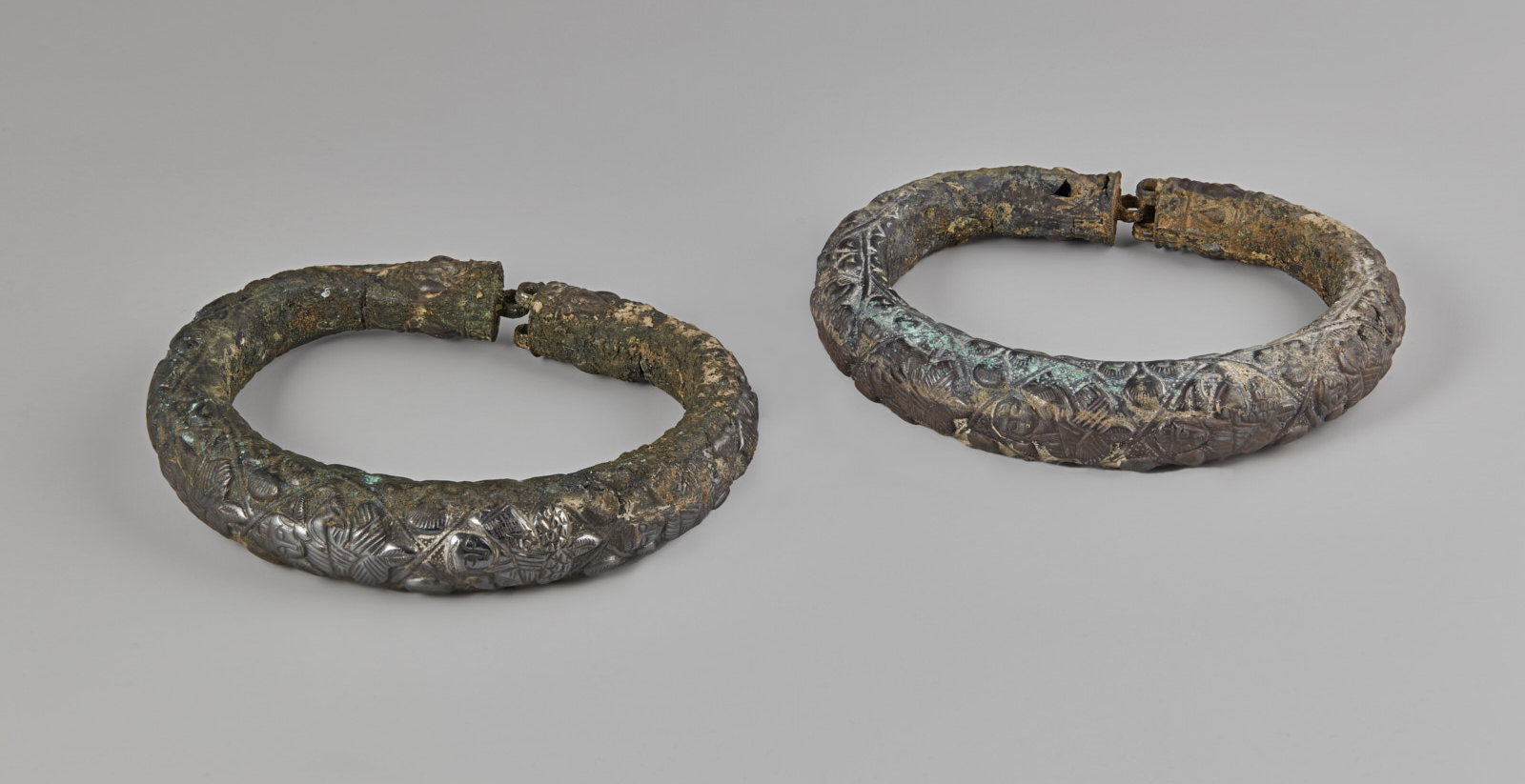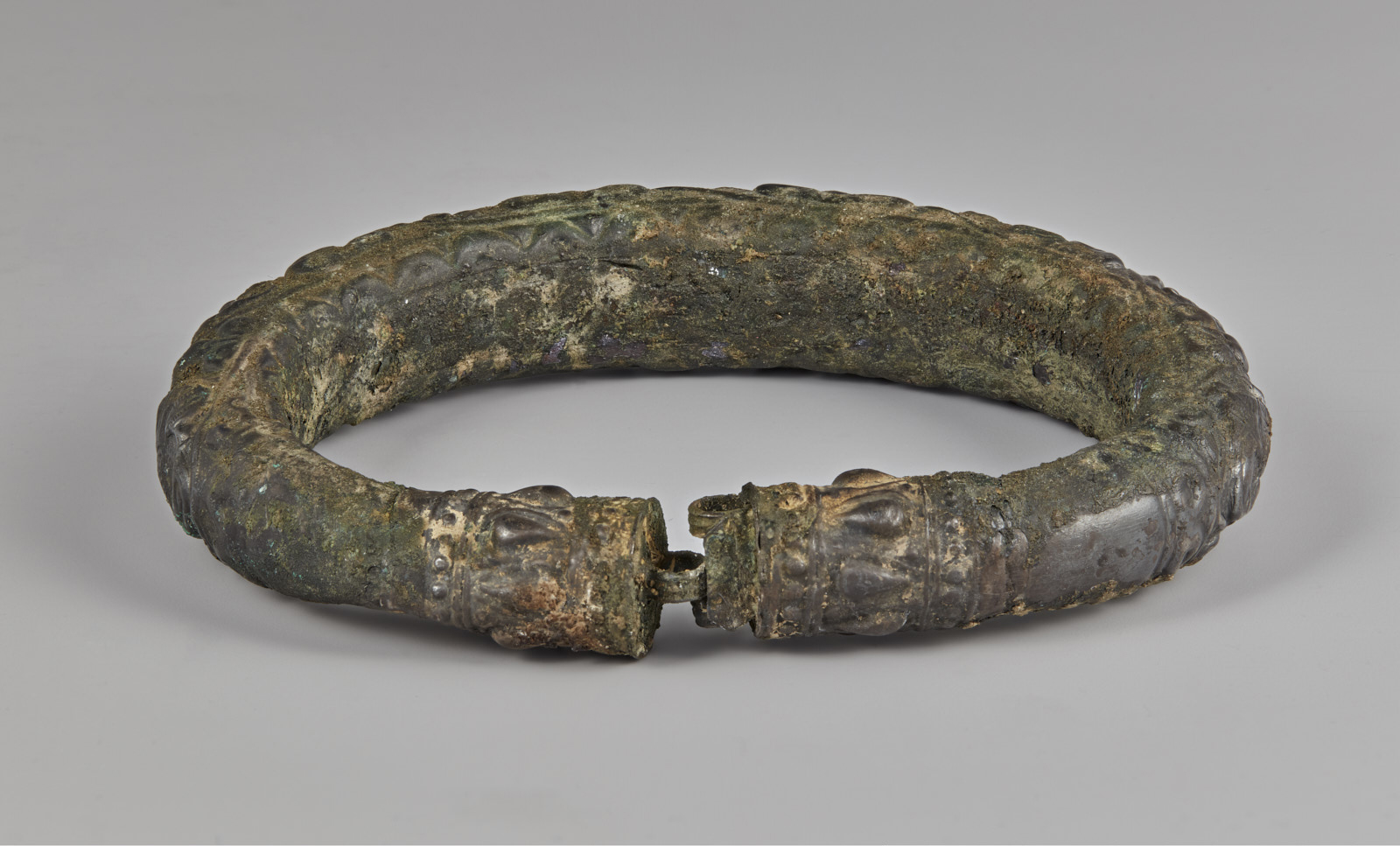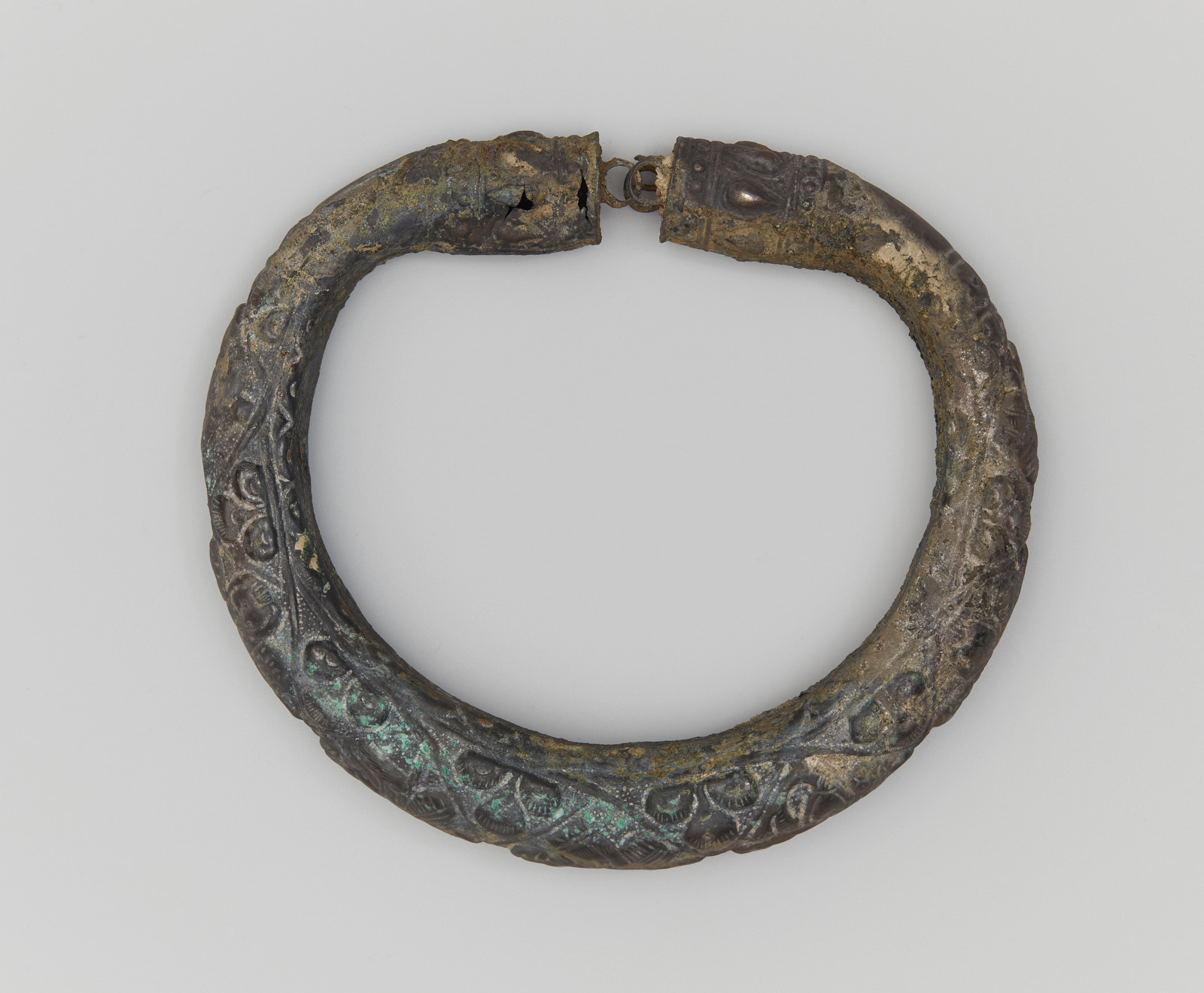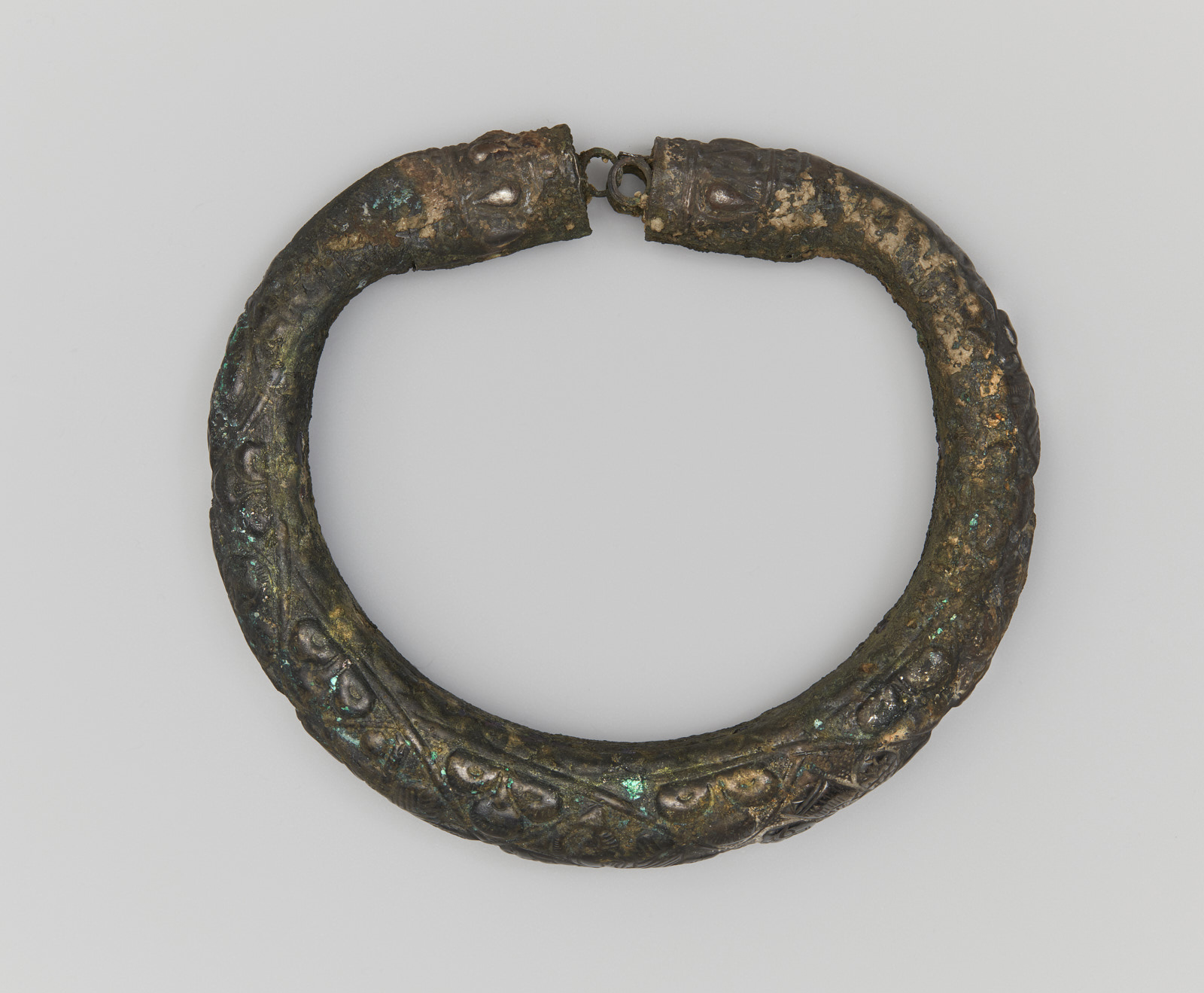Click on the image to zoom
Pair of silver armlets or anklets
- Accession Number:AKM600a, AKM600b
- Place:Egypt or Syria
- Dimensions:Diameter: 13 cm
- Date:11th-12th century
- Materials and Technique:silver with repoussé and chased decoration
Containing small metal components that make a pleasant sound when moved, these large, highly ornate silver armlets or anklets would have been worn in a stunning ensemble of jewellery.[1] They feature depictions of five figures, including musicians playing a variety of instruments. Such celebratory scenes evoke the rich world of the Fatimid Empire (909–1171), one of the most prosperous and triumphant dynasties of the medieval world.
Further Reading
Deriving their name from Fatima, daughter of the Prophet Muhammad, the Fatimids ruled from the seat of their empire in Cairo (Al-Qahira, literally “The Triumphant”). At its greatest expanse, Fatimid territory stretched west across North Africa reaching Morocco, and extending as far east as the Levant and Hijaz (modern-day Saudi Arabia).[2] This wide span of territory enabled the Fatimids to maintain important trade relations within Africa, as well as with empires around the Indian Ocean and Mediterranean Sea.
While similar silver armlets or anklets are known, including those in the collection of the L. A. Memorial Mayer Institute for Islamic Art in Jerusalem (inv. No. J239)[3] as well as a pair in the al-Sabah collection, Kuwait (LNS 68 J a-b), [4] gold jewellery is much better known than silver from the Fatimid period. (Indeed, gold armlets or anklets similar to those in the Aga Khan Museum Collection are held in the collections of the Louvre Museum (MAO 495) [5] and Staatlische Museum Berlin (No. I. 2861).) [6] Local deposits of gold in Egypt resulted in a plethora of gold stores, and objects from this period were made from newly mined gold or from melting down older jewels and repurposing the metal. The near dearth of silver objects surviving from the Fatimid period may be due to the fact that silver was exploited as currency reserves in times of financial distress and would be melted down and converted to coinage. Moreover, the infamous looting of the treasury of Fatimid Caliph al-Mustansir (1036–94) around 1070 resulted in the loss of many riches from this period.
These armlets or anklets may have been produced in Caesarea (modern-day Israel), or traded there, as we know these types of ornaments were in use at this site. The excavation of a hoard of metal vessels in Caesarea include a group of similar Fatimid-era silver bracelets now housed in the Israel Museum (IAA 1961-1286-631).[7] In 2015 a mass of 2,000 gold dinars from the 11th century was found by scuba divers on the ocean floor near Caesarea, an indication of the tremendous riches of the Fatimid dynasty in its heyday.
— Courtney Stewart
Notes
[1] Representations of figures wearing similar objects as armbands can be seen in contemporary works of art from the period, including a small bronze figurine in the Islamic art museum Cairo (MIA 6983).
[2] See Jonathan M. Bloom, Arts of the City Victorious. New Haven and London: Yale University Press, 2007, 2.
[3] Published in Rachel Ḥason. Early Islamic Jewellery: L. A. Memorial Mayer Institute for Islamic Art Jerusalem: L. A. Mayer Memorial Inst. for Islamic Art, 1987, 71.
[4] Trésors Fatimides du Caire Exposition Présentée à l'Institut du Monde Arabe du 28 Avril au 30 Aout 1998. Paris: Institut du Monde Arabe, 1998, 131.
[5] Bracelet aux musiciens; Egypte ou Syrie; 11e siècle; Or repoussé, gravé, filigrané; Ancienne collection L. de Cler ; don H. de Boisgelin, 1967; Département des Arts de l'Islam, inv.no MAO 495 http://cartelfr.louvre.fr/cartelfr/visite?srv=car_not_frame&idNotice=33065
[6] Bracelet; Egypt; 12th century; Gold, driven, hallmarked; Collection: Museum of Islamic Art, ID No. I. 2861. http://www.smb-digital.de/eMuseumPlusservice=ExternalInterface&module=collection&objectId=1524044
[7] Bracelet hoard; Caesarea; Fatimid period, 11th century; Silver, repousse; Israel Museum, Jerusalem, IAA:1961-1286-631 https://www.imj.org.il/en/collections/370403
References
Bloom, Jonathan M. Arts of the City Victorious. New Haven and London: Yale University Press, 2007. ISBN: 9780300135428
Goitein, Shelomoh D. A Mediterranean Society: The Jewish Communities of the Arab World As Portrayed in the Documents of the Cairo Geniza. Berkeley: University of California Press, 1999. ISBN: 9780520221581
Ḥason, Rachel. Early Islamic Jewellery: L. A. Memorial Mayer Institute for Islamic Art. Jerusalem: L. A. Mayer Memorial Institute for Islamic Art, 1987.
Melikian-Chirvani, Assadullah S. The World of the Fatimids. Aga Khan Museum, Toronto, Ontario. Munich: Hirmer, 2018. ISBN: 9783777430379
Müller, Hans, and Eberhard, Thiem. Gold of the Pharaohs. Ithaca: Cornell University Press, 1999. ISBN: 9780801437250
Nuʻmān, ibn M. A. H, and Hamid Haji. Founding the Fatimid State: The Rise of an Early Islamic Empire: an Annotated English Translation of Al-Qāḍī Al-Nuʻmān's Iftitāḥ Al-Daʻwa. London: I. B. Tauris, 2006. ISBN: 9781850438854
O'Kane, Bernard. The Treasures of Islamic Art in the Museums of Cairo. Cairo: American University in Cairo Press, 2006. ISBN: 9789774248603
Spink, Michael and Jack Ogden. The Art of Adornment; Jewellery of the Islamic Lands. Part I and Part II. London: Nour Foundation, 2013. ISBN: 9781874780861
Trésors Fatimides du Caire Exposition Présentée à l'Institut du Monde Arabe du 28 Avril au 30 Aout 1998. Paris: Institut du Monde Arabe, 1998. ISBN: 9782843060113
“Israel’s Underwater Ancient Treasure” BBC Travel, November 9, 2017. http://www.bbc.com/travel/story/20171106-israels-ancient-underwater-treasure.
“Archaeologists Stumble Across a Hoard of Gold” National Geographic, February 20, 2015. https://news.nationalgeographic.com/news/2015/02/150219-gold-hoard-coins-dinars-israel-fatimid-caesarea-archaeology/.
Note: This online resource is reviewed and updated on an ongoing basis. We are committed to improving this information and will revise and update knowledge about this object as it becomes available.














